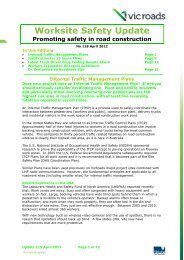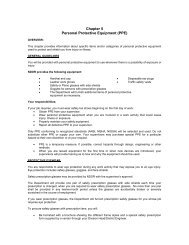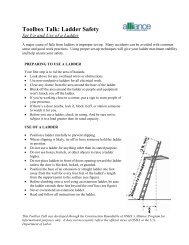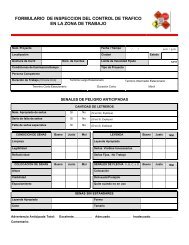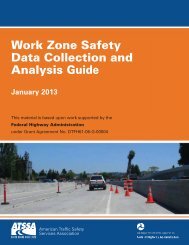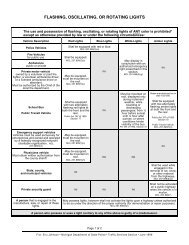California Joint Utility Traffic Control Manual - National Work Zone ...
California Joint Utility Traffic Control Manual - National Work Zone ...
California Joint Utility Traffic Control Manual - National Work Zone ...
Create successful ePaper yourself
Turn your PDF publications into a flip-book with our unique Google optimized e-Paper software.
<strong>California</strong> <strong>Joint</strong> <strong>Utility</strong> <strong>Traffic</strong> <strong>Control</strong> <strong>Manual</strong><br />
Table G – Arrow Panel Table<br />
Panel Type Minimum Size Minimum Legibility<br />
Distance<br />
Minimum Number of<br />
Elements<br />
Type A – Low Speed Urban (48 X 24 inches) (0.5 or ½ miles) 12<br />
Areas<br />
Type B or II – Intermediate (60 X 30 inches) (0.75 or ¾ miles) 13<br />
speed facilities or mobile<br />
operations on high –speed<br />
roadways<br />
On State highways<br />
Use 72 X 36 inches<br />
Type C or I – High speed,<br />
high volume motor vehicle<br />
traffic control projects<br />
(96 X 48 inches) (1 mile) 15<br />
Type D – for use on<br />
authorized vehicles<br />
None 0.5 or 1/5 mile 12<br />
Flagger Reference Information<br />
1599 TRAINING OF CONSTRUCTION SITE FLAGGERS<br />
Effective August 22, 2009<br />
(a) Flaggers shall be utilized at locations on a construction site where barricades and<br />
warning signs cannot control the moving traffic.<br />
(b) When flaggers are required, they shall be placed in relation to the equipment or<br />
operation so as to give effective warning.<br />
(c) Placement of warning signs shall be according to the <strong>California</strong> <strong>Manual</strong> on Uniform<br />
<strong>Traffic</strong> <strong>Control</strong> Devices for Streets and Highways, September 26, 2006, published by the<br />
State Department of Transportation, which is herein incorporated by reference and<br />
referred to as the "<strong>Manual</strong>."<br />
(d) Flaggers shall wear warning garments such as vests, jackets, or shirts manufactured<br />
in accordance with the requirements of the American <strong>National</strong> Standards Institute<br />
(ANSI)/International Safety Equipment Association (ISEA) 107-2004, High Visibility<br />
Safety Apparel and Headwear.<br />
(e) During the hours of darkness, flaggers' stations shall be illuminated such that the<br />
flagger will be clearly visible to approaching traffic and flaggers shall be outfitted with<br />
reflectorized garments manufactured in accordance with the requirements of the<br />
American <strong>National</strong> Standards Institute (ANSI)/ International Safety Equipment<br />
Association (ISEA) 107-2004, High Visibility Safety Apparel and Headwear. The<br />
retroreflective material shall be visible at a minimum distance of 1,000 feet. White outer<br />
garments with retroreflective material that meets the above requirements may be worn<br />
during hours of darkness but not during snow or fog conditions, in lieu of colored vests,<br />
jackets and/or shirts.<br />
(f) The employer shall select the proper type (class) of high visibility safety apparel for a<br />
given occupational activity by consulting the <strong>Manual</strong>, apparel manufacturer, ANSI/ISEA<br />
107-2004, Appendix B or the American <strong>Traffic</strong> Safety Services Association (ATSSA).<br />
20



